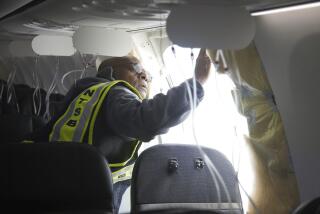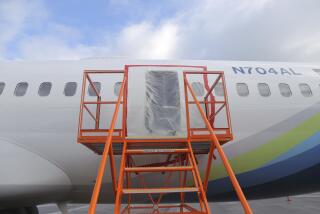Boeing 737 Max that crashed in Ethiopia was set to dive, a piece of wreckage hints

A screw-like device found in the wreckage of the Boeing Co. 737 Max 8 that crashed Sunday in Ethiopia has provided investigators with an early clue into what happened as work begins in France to decode the “black boxes” recovered from the scene.
The so-called jackscrew, used to set the trim that raises and lowers the plane’s nose, indicates that the jet was configured to dive, based on a preliminary review, according to a person familiar with the investigation. The evidence helped persuade U.S. regulators to ground the model, said the person, who requested anonymity to discuss the inquiry.
France’s aviation safety agency BEA received the cockpit voice and data recorders Thursday for analysis, while investigators on the scene near Addis Ababa continued to sift through the plane’s wreckage. The second crash of a 737 Max in five months has thrown Boeing into a crisis, sending the company’s stock plunging and raising questions about the future of its bestselling jet.
Separately, the New York Times reported that the doomed Ethiopian Airlines Flight 302 to Nairobi was in trouble almost immediately after takeoff as it lurched up and down hundreds of feet at a time. The captain asked in a panicky voice to turn back only three minutes into the flight as the plane accelerated to abnormal speeds, the newspaper reported, citing an unnamed person who reviewed the jet’s air traffic communications.
“Break break, request back to home,” he told air traffic controllers as they scrambled to divert two other flights approaching the airport. The aircraft had accelerated far beyond what is considered standard practice. All contact between air controllers and the aircraft was lost five minutes after it took off, the report said.
U.S. Federal Aviation Administration chief Daniel Elwell on Wednesday cited unspecified evidence found at the crash scene as part of the justification for the agency to reverse course and temporarily halt flights of 737 Max planes. Up until then, U.S. regulators had held off, even as nation after nation grounded the model.
How a 50-year design came back to haunt Boeing with its troubled 737 Max jet »
Boeing shares, which had plunged more than 12%, or $28 billion, in market value since the crash in Ethiopia on Sunday, closed up 1.5% Friday, at $378.89.
The jackscrew, combined with a newly obtained satellite flight track of the plane, convinced the FAA that there were similarities to the Oct. 29 crash of the same Max model off the coast of Indonesia. In the October accident, it was determined that a safety feature on the Boeing aircraft malfunctioned and repeatedly put the plane into a dive.
All 157 people aboard the Ethiopian Airlines jet died after the plane crashed near Addis Ababa, Ethiopia’s capital.
In France, where the flight recorders are being analyzed at the BEA’s laboratories, the agency posted a photo of the mangled hardware but has yet to comment on any progress on getting the data. “The investigation process has started in Paris,” Ethiopian Airlines said Friday on Twitter.
The discovery of the jackscrew was reported earlier by NBC News.
More to Read
Inside the business of entertainment
The Wide Shot brings you news, analysis and insights on everything from streaming wars to production — and what it all means for the future.
You may occasionally receive promotional content from the Los Angeles Times.










